|
|
SALT THRONE
The silver 'salt throne' is a traditional object of Russian culture.
Nevertheless its use was limited to a relatively short period: the more
ancient are dated around 1845-50, while their production ceased with the
Bolshevik revolution of 1917. The 'salt thrones' are made of silver, pewter
or silver plated metal. Often they are decorated with bright
coloured cloisonné enamel. There are also 'salt thrones' with full enamel decorations
and a few examples made of birchwood of Karelia. In Russia the salt cellar was kept at the entrance
of the house and a piece of bread dipped in the salt was offered to the guest as a
symbol of welcome. Otherwise the 'salt throne' had the place
of honour on the table. A small piece of bread was leaned on the
seat (at the center of the throne) and the guest dipped the bread in
the salt inside the throne. The back of the throne evokes the classic isba, the small wooden
house of Russian rural architecture, which you can find nearly
anywhere in the northern part of that country: the sharp-ended roof,
the crossed beams and the gable with obvious reference to the house
as a symbol of familiar affection, while the geometrical decorations
symbolize the perfection of the marriage union.The salt cellar, presented to a young couple on
the occasion of their marriage, meant 'Best wishes' or 'We wish you well'.
|

Holes on the back of the seat represented the windows on the house
front, while the superior edge evoked the characteristic undulating
finish of Russian 'isbas'.The back side of the throne has usually a most refined look as,
opening the salt cellar, the view of the front side is covered by
the seat.Since the ancient ages and in all the cultures the salt is a symbol of
life and immortality, faithfulness and friendship. The offer of salt was
a common practice among Arabic people, in Northern Africa and also in
Southern Italy (while in Tuscany a bit of bread with a drop of oil was
usually offered).
The bread evokes fertility and nourishment, both for the body and the
soul. Breaking the bread and touching it on the salt represents and
wishes a harmonious and long lasting friendship.Often on the back of the throne or on the seat there
were phrases expressing best wishes or good fortune: 'Eat bread and salt but also
follow good advice' or 'Without bread and salt, the meal is not
complete'.Sometimes, a rooster, symbol of fertility and love, is represented
on the throne. However this omen is not flaunted and appears only
when the salt is opened (it is engraved on the underside of the seat)
|

www.silvercollection.it |
This is a page of 'The What is? Silver Dictionary' of A Small Collection of
Antique Silver and Objects of vertu,
a 1000 pages richly illustrated website offering all you need to know about
antique silver, sterling silver, silverplate, sheffield plate, electroplate silver,
silverware, flatware, tea services and tea complements, marks and hallmarks, articles,
books, auction catalogs, famous silversmiths (Tiffany, Gorham, Jensen, Elkington),
history, oddities ...
SITE MAP - SILVER DICTIONARY |
| |